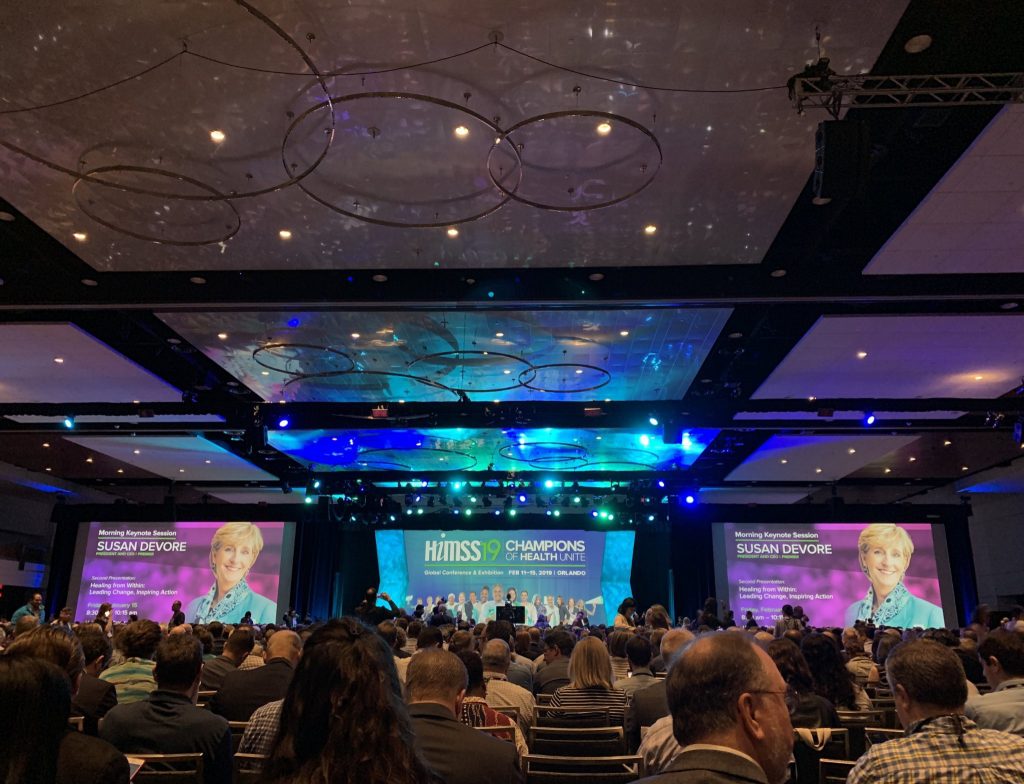Health IT’s annual global conference got under way with daylong sessions specializing in specific industry areas, from patient engagement to higher ed, revenue cycle solutions and healthy aging.
As part of HIMSS19, the Association of University Programs in Health Administration held its 14th annual Academic Forum, providing educators from around the United States with a chance to compare and share teaching experiences.
Educators heard from Lorren Pettit, Vice President of the Office of the Chief Technology and Innovation Officer for the Healthcare Information and Management Systems Society (HIMSS). Pettit is a leading figure in the society’s efforts to influence healthcare in Canada, as well the connected health, behavioral health and long-term, post-acute care markets.
He highlighted a slight adjustment in thinking regarding HIMSS’ mission statement that it will “optimize health engagements and care outcomes through information and technology.”
“It’s not just information technology anymore,” Pettit said. “There’s increased focus on the information, the data, in our dialogue as well.”
That message was echoed by the opening keynote speaker at HIMSS19, which runs from Feb. 11 to 15, 2019.
“Our industry has been focused on information technology; the means to the end,” Cris Ross, Chief Information Officer of Mayo Clinic, told the audience at the Orange County Convention Center in Orlando, Florida. “We’ve been focused on taking healthcare from a paper hard world to a digital one. We’ve automated healthcare, but that’s not summiting the mountain. Now we have to figure out how to use information to transform healthcare.”
Strategies for Growth
Pettit also discussed HIMSS’ ongoing evolution into more areas of healthcare, outlining its five strategies for transforming healthcare through information and technology:
Membership
HIMSS wants to combine its membership categories into a single type, so the Personal Connected Health Alliance (PCHA) and Health 2.0 member networks enjoy the same benefits as regular HIMSS members.
Models
HIMSS offers various adoption models so organizations can score their adoption of healthcare technology. These include the Electronic Medical Record Adoption Model (EMRAM) and the Adoption Model for Analytics Maturity (AMAM), among others. The society sees these as engines for improving patient care insights and hopes to release new models in the coming months.
Innovation
HIMSS supports efforts such as Healthbox, an advisory service designed to drive support, strategy and investment in innovation, and the Health 2.0 network connecting innovators with healthcare providers and investors.
International
Since rebranding its annual conference as a global conference, HIMSS’ appeal has broadened, with the society now present throughout the Americas, Europe and Asia, and looking to continue its growth worldwide.
Thought Leadership
As expressed in policy, best practices and research, HIMSS wants to be a strategic leader and counsel to health IT companies of all sizes and types. It will also look to collaborate more with the digital health academic community to achieve its goals in this area.
Security and Privacy
Pettit teased the upcoming release of two annual surveys by HIMSS: Leadership and Workforce; and Cybersecurity.
The two topics are converging in 2019, as security and privacy are top of mind for organizations across the healthcare spectrum. The rise of the Chief Information Security Officer has been significant in recent years, and as the profile of cybersecurity professionals working in healthcare rises, so does their voice.
Among Cybersecurity Survey respondents, 83% said they have some level of managerial responsibility. Pettit spotlighted the emergence of senior security leaders and the “remarkable intensity around security and privacy.”
“That person is starting to trump everyone else now,” he said. “They have the doom-and-gloom message. Hospitals and providers are taking a more defensive position on the issue of security. The provider community wants to secure data first before they spend anywhere else.”
One possible reason for that comes in the form of legacy systems. According to the Cybersecurity Survey, 72% of hospitals have at least one aging system that remains active – and vulnerable to bad actors.
Read more of our HIMSS19 coverage and connect with us live at the conference. USF Health Online is at HIMSS 19 on University Row, booth UR12! Follow us on Facebook, Twitter, LinkedIn and Instagram to stay tuned with what we’re doing at HIMSS 19!



